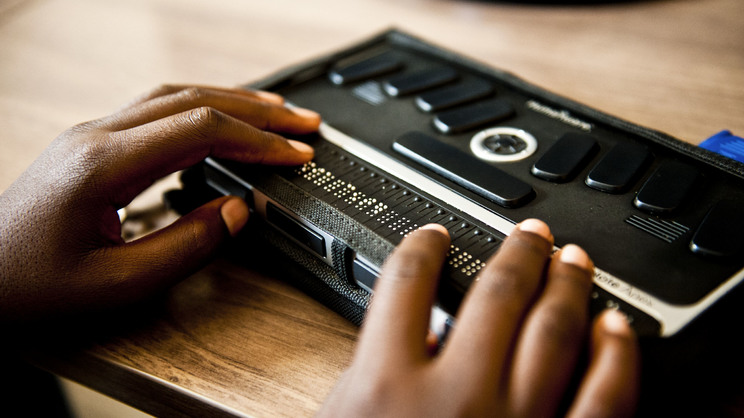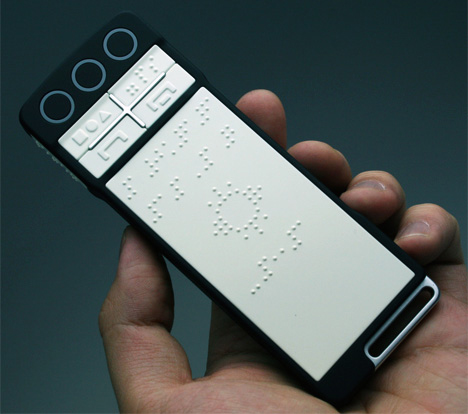Discover Innovative Devices Made for the Aesthetically Damaged
The development of cutting-edge tools for the aesthetically impaired represents a considerable improvement in access and freedom. Technologies such as wise glasses with AI capabilities and mobile applications made to give acoustic descriptions are reshaping everyday experiences for customers.
Smart Glasses for Navigation

Smart glasses created for navigation are reinventing the way aesthetically damaged people communicate with their setting. These advanced tools use a combination of electronic camera modern technology, expert system, and acoustic feedback to offer real-time information regarding surroundings. By using barrier detection systems, clever glasses can alert users to possible threats, allowing more secure mobility in both acquainted and unfamiliar settings.
The integration of GPS modern technology further boosts navigating capabilities, allowing customers to receive auditory instructions as they relocate. This hands-free approach not just cultivates self-reliance however likewise equips visually damaged people to navigate urban landscapes with increased self-confidence. Furthermore, several wise glasses are geared up with attributes that recognize spots and road indications, giving contextual information that improves the individual experience.
In addition, the advancement of these devices is continually progressing, with business functioning to boost the precision of object recognition and expand the variety of navigational functions. As wise glasses end up being a lot more cost effective and available, they hold the possible to significantly transform day-to-day live for aesthetically damaged users. Inevitably, these cutting-edge devices represent a crucial action toward inclusivity, offering improved movement and a better feeling of autonomy for individuals navigating the globe around them.

Mobile Application for Daily Living
Just how can mobile applications boost the every day lives of visually impaired people? Mobile apps are reinventing the way aesthetically impaired individuals browse their settings, handle daily jobs, and gain access to details. These applications offer essential assistance through numerous capabilities, cultivating freedom and enhancing high quality of life.
Several innovative mobile apps are created especially for day-to-day living. For circumstances, applications like Be My Eyes link aesthetically impaired individuals with sighted volunteers via video telephone calls, allowing them to obtain real-time support with tasks such as checking out labels or browsing unfamiliar rooms. Likewise, Seeing AI, established by Microsoft, makes use of expert system to describe environments, checked out message, and recognize items, successfully transforming a smartphone right into a powerful device for daily help.
Furthermore, navigating applications customized for the aesthetically impaired, such as Aira and BlindSquare, provide audio-based instructions and ecological information, enabling individuals to traverse their surroundings safely and with confidence. Beyond navigating and instant help, mobile apps likewise sustain company and task administration, with functions that help users establish pointers, develop to-do lists, and track appointments. In summary, mobile applications offer as vital sources, empowering visually impaired individuals to lead more independent and fulfilling lives.
Wearable Technologies for Assistance
Empowerment via modern technology is significantly obvious in the world of wearable devices developed to aid visually damaged people. These ingenious tools integrate flawlessly into every day life, improving navigation and supplying important feedback to individuals. For instance, clever glasses equipped with electronic cameras can recognize faces and review text out loud, allowing customers to interact even more confidently in professional and social setups.
Another noteworthy development is making use of haptic comments systems in wearable gadgets. These systems utilize vibrations or other responsive signals to convey information about the customer's setting, such as barriers or changes in terrain, improving wheelchair and safety and security. Wearable technologies also consist of wristbands that link to smart devices, alerting individuals to alerts with subtle vibrations, thus boosting connectivity without reliance on aesthetic hints.
As these innovations remain to evolve, they are not only improving self-reliance for visually impaired individuals but likewise fostering a better feeling of inclusion in culture. By bridging the void in between difficulties encountered in everyday living and the possibility for autonomy, wearable technologies act as pivotal tools in the mission for equal rights and empowerment for those with aesthetic impairments.
Sound Summary Devices
Sound summary tools play a critical role in improving access for aesthetically impaired people, offering them with the capability to engage with visual media. OCR devices gold glasses frames for the blind. These tools provide narrated summaries of key visual components in movies, television shows, and live performances, making certain that users can totally understand the context and feelings communicated with visuals
Audio description can be integrated into various systems, consisting of streaming solutions, movie theater testings, and live movie theater. Several prominent streaming solutions currently include audio summary as an ease of access feature, allowing visitors to select it quickly. Along with mainstream media, specialized applications also exist, offering audio descriptions for art exhibits, galleries, and other social events.
The performance of audio summary depends upon the skill of the storytellers, that need to convey visual information succinctly without taking away from the original sound. Developments in this field are additionally leading the way for more tailored experiences, where individuals can adjust the degree of information and pacing according to their preferences.
Braille Innovations and Gadgets
Braille technologies and tools have dramatically transformed the way aesthetically damaged individuals engage with message and info. Modern innovations have led to the growth of functional devices that improve proficiency and freedom amongst users.
Furthermore, portable Braille notetakers integrate traditional Braille input with modern functionalities, assisting in note-taking, scheduling, and record editing on the go. AI-powered visual aids. These compact gadgets often feature text-to-speech capacities, linking the gap between Braille and auditory info
On top of that, ingenious Braille printers have actually emerged, allowing individuals to create Braille tags, papers, and academic products efficiently. This ease of access fosters greater participation in instructional and expert atmospheres, eventually promoting inclusivity.
Furthermore, research right into wise Braille innovations continues to increase. Gadgets that incorporate artificial intelligence are being explored to provide real-time navigation assistance and contextual details, improving the customer experience in varied settings. Generally, these advancements show a commitment to equipping visually damaged people with modern technology, ensuring they can conveniently access and engage with the world around them.

Final Thought
The development of cutting-edge devices for the visually impaired dramatically enhances like this independence and high quality of life. These modern technologies not only foster higher inclusion but also Home Page advertise freedom in everyday tasks, ultimately contributing to an extra available and equitable culture for aesthetically impaired individuals.
As clever glasses end up being extra obtainable and affordable, they hold the potential to significantly change everyday life for aesthetically impaired customers. Mobile apps are revolutionizing the way visually impaired customers navigate their settings, manage daily jobs, and accessibility details. Applications like Be My Eyes connect visually impaired individuals with sighted volunteers using video phone calls, enabling them to receive real-time support with jobs such as checking out labels or navigating unknown areas.In addition, navigating apps tailored for the aesthetically impaired, such as Aira and BlindSquare, use audio-based instructions and ecological info, making it possible for individuals to traverse their surroundings securely and confidently.The innovation of innovative devices for the aesthetically damaged significantly boosts freedom and high quality of life.